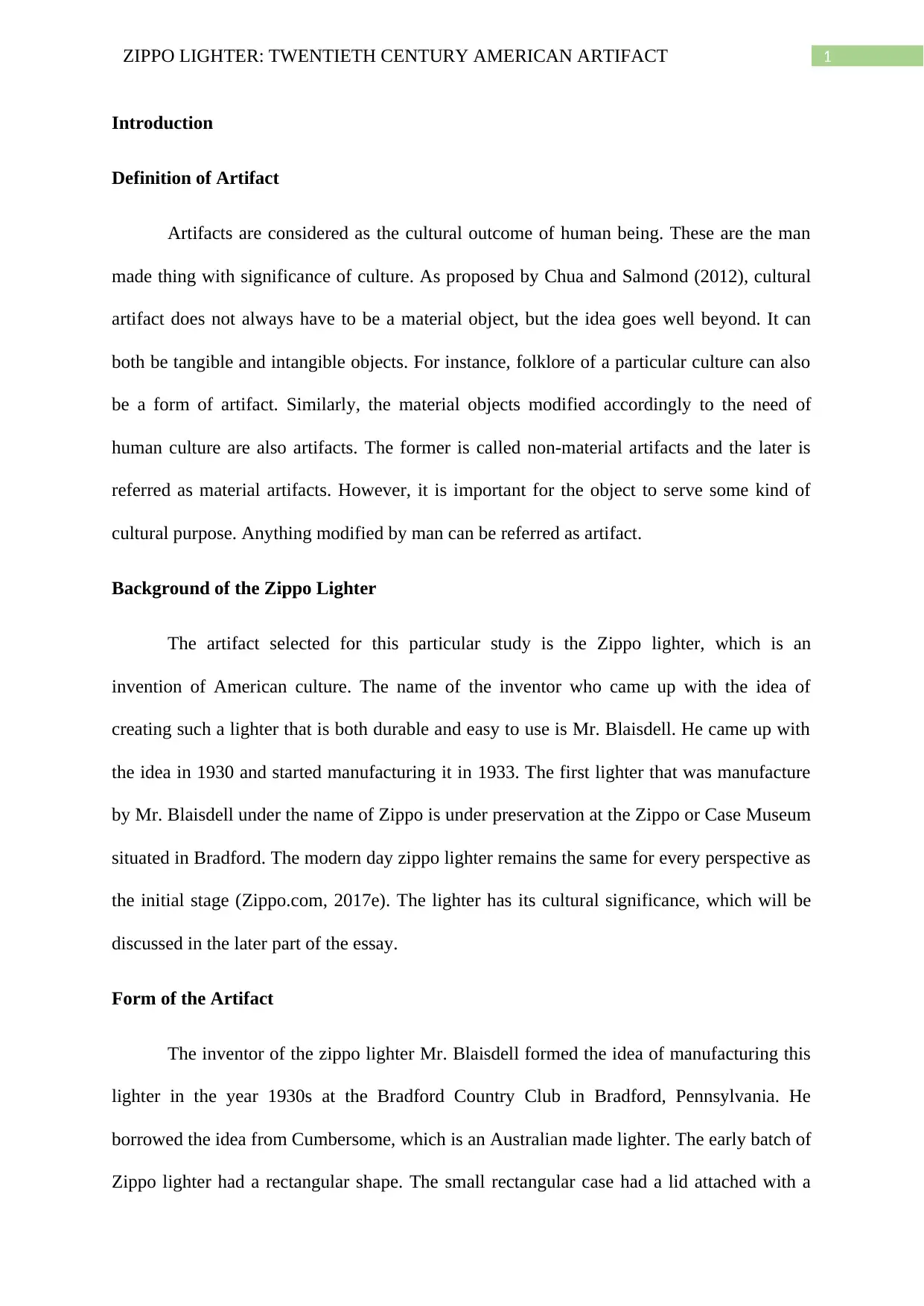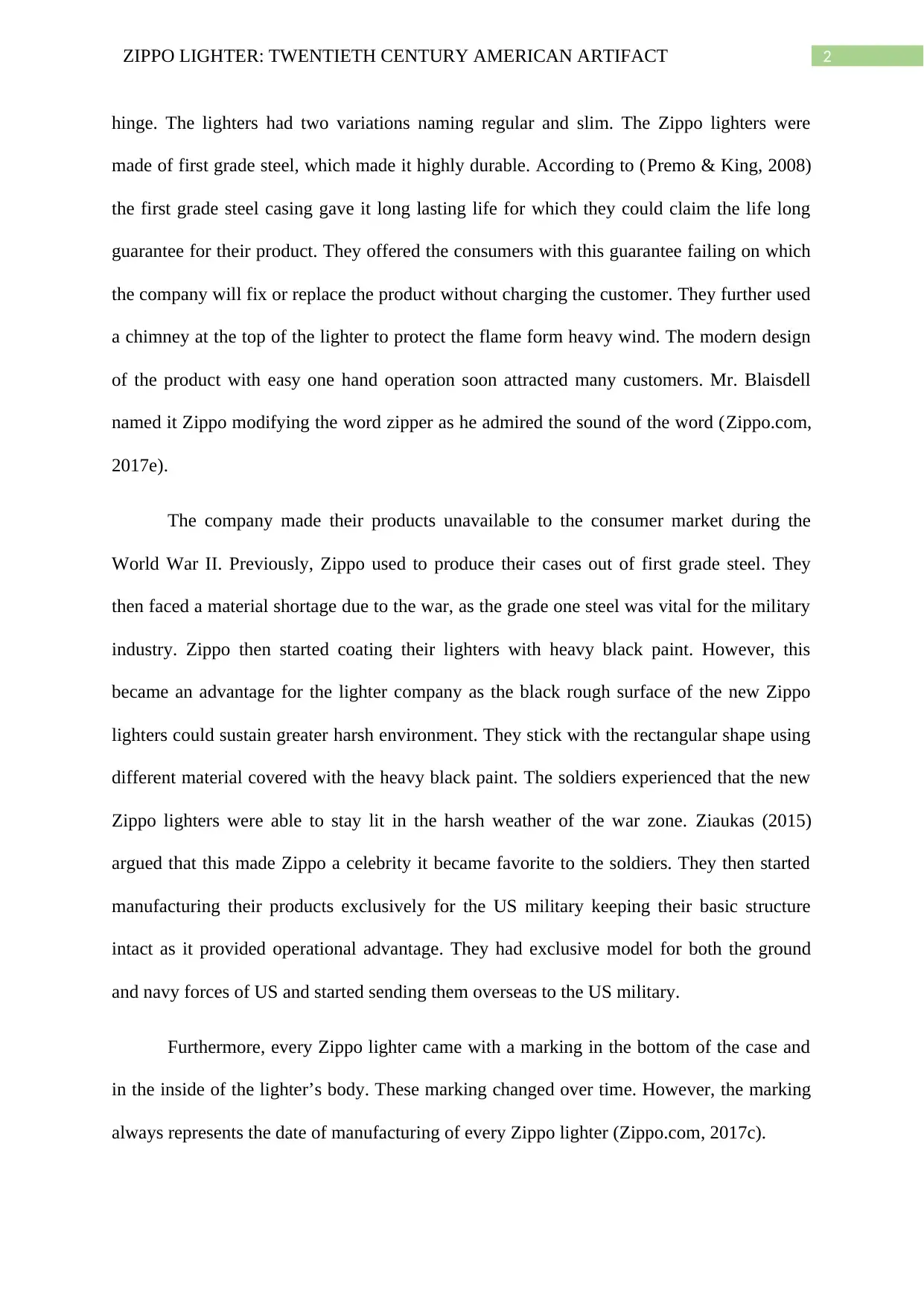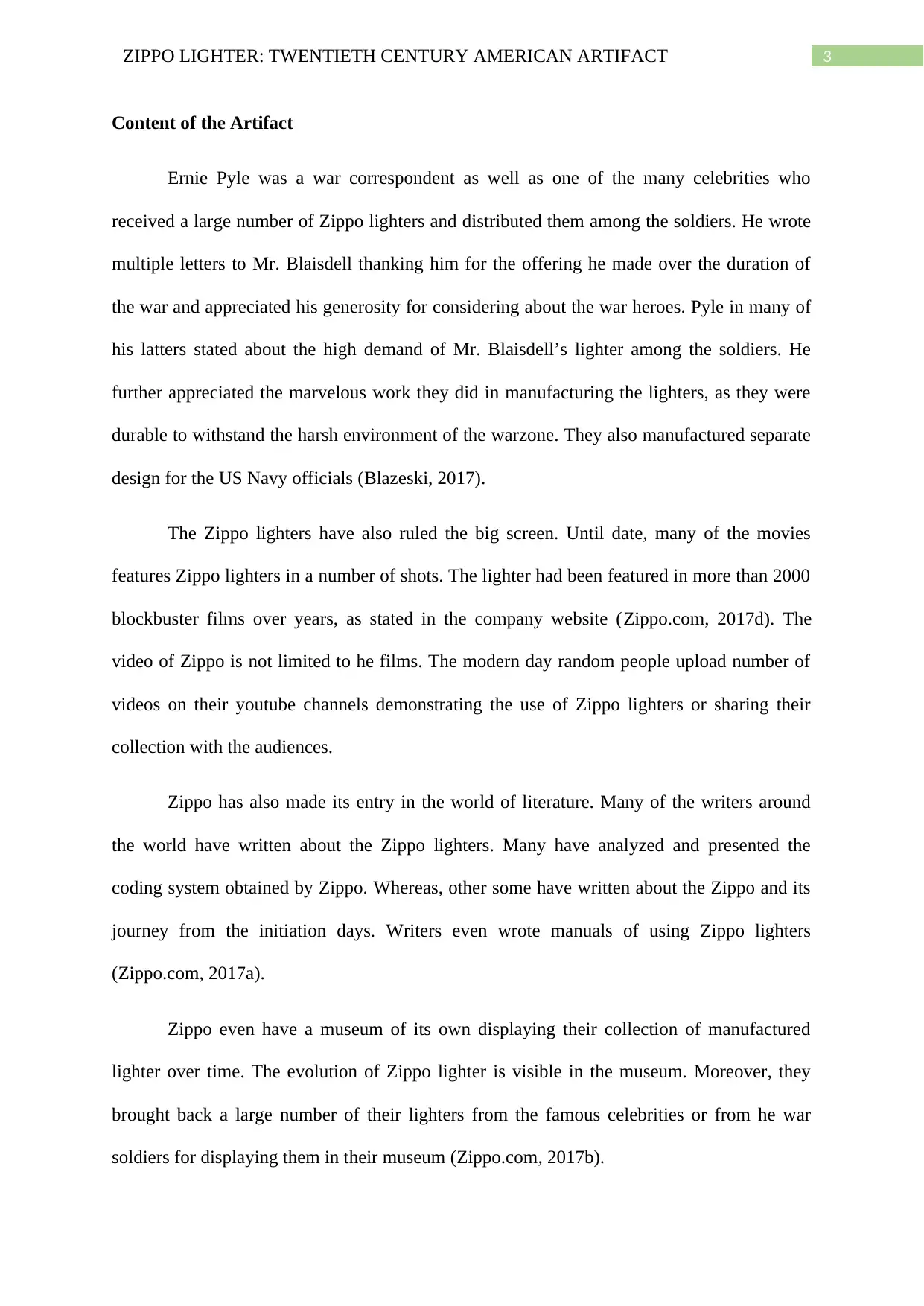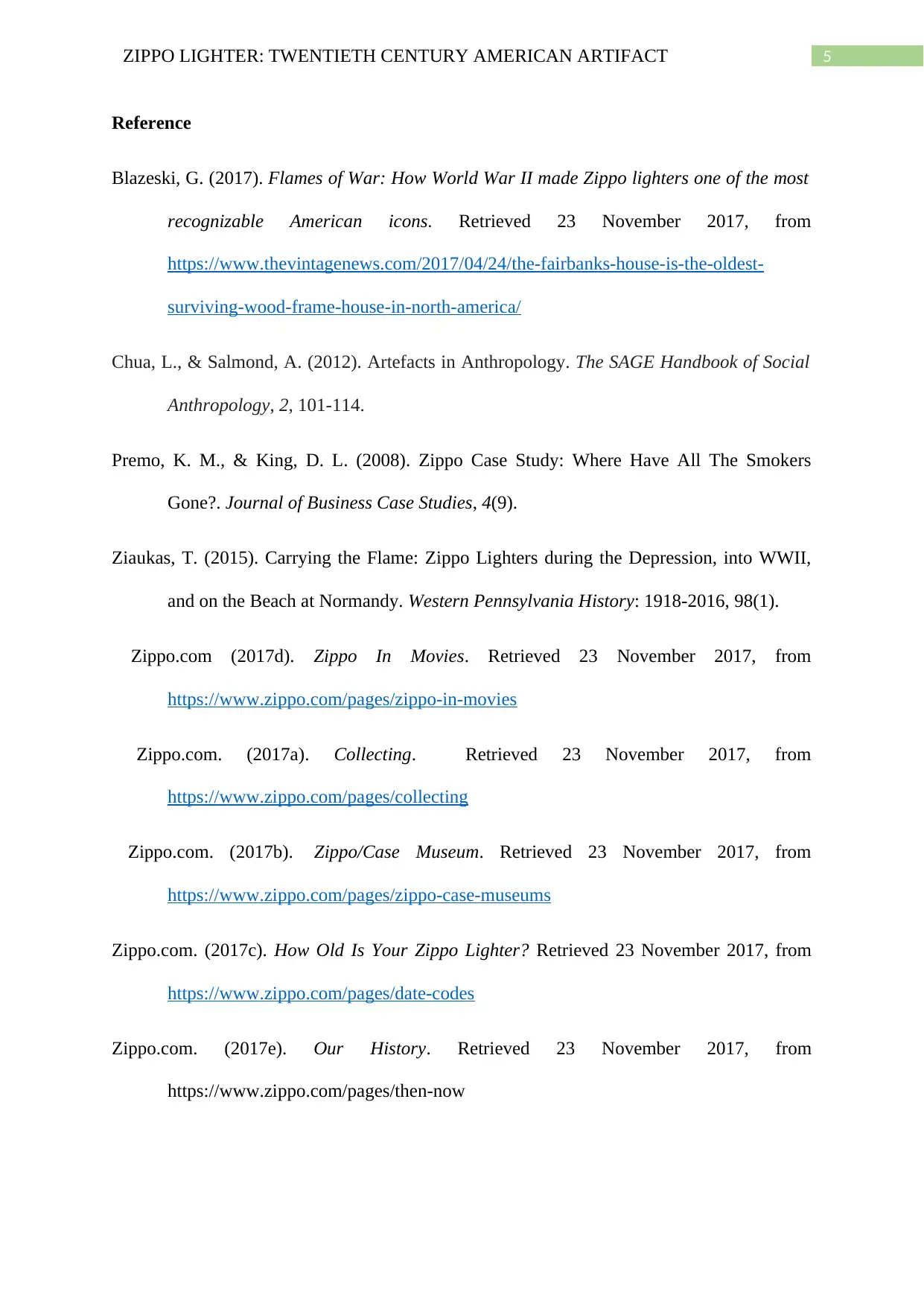Zippo Lighter: Twentieth Century American Artifact Analysis
VerifiedAdded on 2020/04/15
|7
|1408
|415
Essay
AI Summary
This essay examines the Zippo lighter as a twentieth-century American artifact, delving into its history, design, and cultural significance. The essay begins by defining artifacts and their cultural importance, then focuses on the Zippo lighter, discussing its inventor, Mr. Blaisdell, and its origins in the 1930s. It details the lighter's rectangular shape, steel construction, and windproof design, highlighting its evolution and wartime adaptations, including the use of black paint during World War II. The essay emphasizes the Zippo's popularity among soldiers and its presence in movies, literature, and museums, concluding that the Zippo lighter has made a significant impact on American culture and beyond. The essay references several sources to support its claims, including Zippo.com, and other academic journals.

Running head: ZIPPO LIGHTER: TWENTIETH CENTURY AMERICAN ARTIFACT
Zippo Lighter: Twentieth Century American Artifact
Name of the Student
Name of the University
Author’s Note
Zippo Lighter: Twentieth Century American Artifact
Name of the Student
Name of the University
Author’s Note
Paraphrase This Document
Need a fresh take? Get an instant paraphrase of this document with our AI Paraphraser

1ZIPPO LIGHTER: TWENTIETH CENTURY AMERICAN ARTIFACT
Introduction
Definition of Artifact
Artifacts are considered as the cultural outcome of human being. These are the man
made thing with significance of culture. As proposed by Chua and Salmond (2012), cultural
artifact does not always have to be a material object, but the idea goes well beyond. It can
both be tangible and intangible objects. For instance, folklore of a particular culture can also
be a form of artifact. Similarly, the material objects modified accordingly to the need of
human culture are also artifacts. The former is called non-material artifacts and the later is
referred as material artifacts. However, it is important for the object to serve some kind of
cultural purpose. Anything modified by man can be referred as artifact.
Background of the Zippo Lighter
The artifact selected for this particular study is the Zippo lighter, which is an
invention of American culture. The name of the inventor who came up with the idea of
creating such a lighter that is both durable and easy to use is Mr. Blaisdell. He came up with
the idea in 1930 and started manufacturing it in 1933. The first lighter that was manufacture
by Mr. Blaisdell under the name of Zippo is under preservation at the Zippo or Case Museum
situated in Bradford. The modern day zippo lighter remains the same for every perspective as
the initial stage (Zippo.com, 2017e). The lighter has its cultural significance, which will be
discussed in the later part of the essay.
Form of the Artifact
The inventor of the zippo lighter Mr. Blaisdell formed the idea of manufacturing this
lighter in the year 1930s at the Bradford Country Club in Bradford, Pennsylvania. He
borrowed the idea from Cumbersome, which is an Australian made lighter. The early batch of
Zippo lighter had a rectangular shape. The small rectangular case had a lid attached with a
Introduction
Definition of Artifact
Artifacts are considered as the cultural outcome of human being. These are the man
made thing with significance of culture. As proposed by Chua and Salmond (2012), cultural
artifact does not always have to be a material object, but the idea goes well beyond. It can
both be tangible and intangible objects. For instance, folklore of a particular culture can also
be a form of artifact. Similarly, the material objects modified accordingly to the need of
human culture are also artifacts. The former is called non-material artifacts and the later is
referred as material artifacts. However, it is important for the object to serve some kind of
cultural purpose. Anything modified by man can be referred as artifact.
Background of the Zippo Lighter
The artifact selected for this particular study is the Zippo lighter, which is an
invention of American culture. The name of the inventor who came up with the idea of
creating such a lighter that is both durable and easy to use is Mr. Blaisdell. He came up with
the idea in 1930 and started manufacturing it in 1933. The first lighter that was manufacture
by Mr. Blaisdell under the name of Zippo is under preservation at the Zippo or Case Museum
situated in Bradford. The modern day zippo lighter remains the same for every perspective as
the initial stage (Zippo.com, 2017e). The lighter has its cultural significance, which will be
discussed in the later part of the essay.
Form of the Artifact
The inventor of the zippo lighter Mr. Blaisdell formed the idea of manufacturing this
lighter in the year 1930s at the Bradford Country Club in Bradford, Pennsylvania. He
borrowed the idea from Cumbersome, which is an Australian made lighter. The early batch of
Zippo lighter had a rectangular shape. The small rectangular case had a lid attached with a

2ZIPPO LIGHTER: TWENTIETH CENTURY AMERICAN ARTIFACT
hinge. The lighters had two variations naming regular and slim. The Zippo lighters were
made of first grade steel, which made it highly durable. According to (Premo & King, 2008)
the first grade steel casing gave it long lasting life for which they could claim the life long
guarantee for their product. They offered the consumers with this guarantee failing on which
the company will fix or replace the product without charging the customer. They further used
a chimney at the top of the lighter to protect the flame form heavy wind. The modern design
of the product with easy one hand operation soon attracted many customers. Mr. Blaisdell
named it Zippo modifying the word zipper as he admired the sound of the word (Zippo.com,
2017e).
The company made their products unavailable to the consumer market during the
World War II. Previously, Zippo used to produce their cases out of first grade steel. They
then faced a material shortage due to the war, as the grade one steel was vital for the military
industry. Zippo then started coating their lighters with heavy black paint. However, this
became an advantage for the lighter company as the black rough surface of the new Zippo
lighters could sustain greater harsh environment. They stick with the rectangular shape using
different material covered with the heavy black paint. The soldiers experienced that the new
Zippo lighters were able to stay lit in the harsh weather of the war zone. Ziaukas (2015)
argued that this made Zippo a celebrity it became favorite to the soldiers. They then started
manufacturing their products exclusively for the US military keeping their basic structure
intact as it provided operational advantage. They had exclusive model for both the ground
and navy forces of US and started sending them overseas to the US military.
Furthermore, every Zippo lighter came with a marking in the bottom of the case and
in the inside of the lighter’s body. These marking changed over time. However, the marking
always represents the date of manufacturing of every Zippo lighter (Zippo.com, 2017c).
hinge. The lighters had two variations naming regular and slim. The Zippo lighters were
made of first grade steel, which made it highly durable. According to (Premo & King, 2008)
the first grade steel casing gave it long lasting life for which they could claim the life long
guarantee for their product. They offered the consumers with this guarantee failing on which
the company will fix or replace the product without charging the customer. They further used
a chimney at the top of the lighter to protect the flame form heavy wind. The modern design
of the product with easy one hand operation soon attracted many customers. Mr. Blaisdell
named it Zippo modifying the word zipper as he admired the sound of the word (Zippo.com,
2017e).
The company made their products unavailable to the consumer market during the
World War II. Previously, Zippo used to produce their cases out of first grade steel. They
then faced a material shortage due to the war, as the grade one steel was vital for the military
industry. Zippo then started coating their lighters with heavy black paint. However, this
became an advantage for the lighter company as the black rough surface of the new Zippo
lighters could sustain greater harsh environment. They stick with the rectangular shape using
different material covered with the heavy black paint. The soldiers experienced that the new
Zippo lighters were able to stay lit in the harsh weather of the war zone. Ziaukas (2015)
argued that this made Zippo a celebrity it became favorite to the soldiers. They then started
manufacturing their products exclusively for the US military keeping their basic structure
intact as it provided operational advantage. They had exclusive model for both the ground
and navy forces of US and started sending them overseas to the US military.
Furthermore, every Zippo lighter came with a marking in the bottom of the case and
in the inside of the lighter’s body. These marking changed over time. However, the marking
always represents the date of manufacturing of every Zippo lighter (Zippo.com, 2017c).
⊘ This is a preview!⊘
Do you want full access?
Subscribe today to unlock all pages.

Trusted by 1+ million students worldwide

3ZIPPO LIGHTER: TWENTIETH CENTURY AMERICAN ARTIFACT
Content of the Artifact
Ernie Pyle was a war correspondent as well as one of the many celebrities who
received a large number of Zippo lighters and distributed them among the soldiers. He wrote
multiple letters to Mr. Blaisdell thanking him for the offering he made over the duration of
the war and appreciated his generosity for considering about the war heroes. Pyle in many of
his latters stated about the high demand of Mr. Blaisdell’s lighter among the soldiers. He
further appreciated the marvelous work they did in manufacturing the lighters, as they were
durable to withstand the harsh environment of the warzone. They also manufactured separate
design for the US Navy officials (Blazeski, 2017).
The Zippo lighters have also ruled the big screen. Until date, many of the movies
features Zippo lighters in a number of shots. The lighter had been featured in more than 2000
blockbuster films over years, as stated in the company website (Zippo.com, 2017d). The
video of Zippo is not limited to he films. The modern day random people upload number of
videos on their youtube channels demonstrating the use of Zippo lighters or sharing their
collection with the audiences.
Zippo has also made its entry in the world of literature. Many of the writers around
the world have written about the Zippo lighters. Many have analyzed and presented the
coding system obtained by Zippo. Whereas, other some have written about the Zippo and its
journey from the initiation days. Writers even wrote manuals of using Zippo lighters
(Zippo.com, 2017a).
Zippo even have a museum of its own displaying their collection of manufactured
lighter over time. The evolution of Zippo lighter is visible in the museum. Moreover, they
brought back a large number of their lighters from the famous celebrities or from he war
soldiers for displaying them in their museum (Zippo.com, 2017b).
Content of the Artifact
Ernie Pyle was a war correspondent as well as one of the many celebrities who
received a large number of Zippo lighters and distributed them among the soldiers. He wrote
multiple letters to Mr. Blaisdell thanking him for the offering he made over the duration of
the war and appreciated his generosity for considering about the war heroes. Pyle in many of
his latters stated about the high demand of Mr. Blaisdell’s lighter among the soldiers. He
further appreciated the marvelous work they did in manufacturing the lighters, as they were
durable to withstand the harsh environment of the warzone. They also manufactured separate
design for the US Navy officials (Blazeski, 2017).
The Zippo lighters have also ruled the big screen. Until date, many of the movies
features Zippo lighters in a number of shots. The lighter had been featured in more than 2000
blockbuster films over years, as stated in the company website (Zippo.com, 2017d). The
video of Zippo is not limited to he films. The modern day random people upload number of
videos on their youtube channels demonstrating the use of Zippo lighters or sharing their
collection with the audiences.
Zippo has also made its entry in the world of literature. Many of the writers around
the world have written about the Zippo lighters. Many have analyzed and presented the
coding system obtained by Zippo. Whereas, other some have written about the Zippo and its
journey from the initiation days. Writers even wrote manuals of using Zippo lighters
(Zippo.com, 2017a).
Zippo even have a museum of its own displaying their collection of manufactured
lighter over time. The evolution of Zippo lighter is visible in the museum. Moreover, they
brought back a large number of their lighters from the famous celebrities or from he war
soldiers for displaying them in their museum (Zippo.com, 2017b).
Paraphrase This Document
Need a fresh take? Get an instant paraphrase of this document with our AI Paraphraser

4ZIPPO LIGHTER: TWENTIETH CENTURY AMERICAN ARTIFACT
Conclusion
One can conclude that the Zippo has made its impact on the American culture. The
impact of this lighter goes beyond the American culture as people around the world
appreciate the marvelous pieces and adds them in their collection. The lighter has gained
quiet a fame and now considered as an integral part of American culture.
Conclusion
One can conclude that the Zippo has made its impact on the American culture. The
impact of this lighter goes beyond the American culture as people around the world
appreciate the marvelous pieces and adds them in their collection. The lighter has gained
quiet a fame and now considered as an integral part of American culture.

5ZIPPO LIGHTER: TWENTIETH CENTURY AMERICAN ARTIFACT
Reference
Blazeski, G. (2017). Flames of War: How World War II made Zippo lighters one of the most
recognizable American icons. Retrieved 23 November 2017, from
https://www.thevintagenews.com/2017/04/24/the-fairbanks-house-is-the-oldest-
surviving-wood-frame-house-in-north-america/
Chua, L., & Salmond, A. (2012). Artefacts in Anthropology. The SAGE Handbook of Social
Anthropology, 2, 101-114.
Premo, K. M., & King, D. L. (2008). Zippo Case Study: Where Have All The Smokers
Gone?. Journal of Business Case Studies, 4(9).
Ziaukas, T. (2015). Carrying the Flame: Zippo Lighters during the Depression, into WWII,
and on the Beach at Normandy. Western Pennsylvania History: 1918-2016, 98(1).
Zippo.com (2017d). Zippo In Movies. Retrieved 23 November 2017, from
https://www.zippo.com/pages/zippo-in-movies
Zippo.com. (2017a). Collecting. Retrieved 23 November 2017, from
https://www.zippo.com/pages/collecting
Zippo.com. (2017b). Zippo/Case Museum. Retrieved 23 November 2017, from
https://www.zippo.com/pages/zippo-case-museums
Zippo.com. (2017c). How Old Is Your Zippo Lighter? Retrieved 23 November 2017, from
https://www.zippo.com/pages/date-codes
Zippo.com. (2017e). Our History. Retrieved 23 November 2017, from
https://www.zippo.com/pages/then-now
Reference
Blazeski, G. (2017). Flames of War: How World War II made Zippo lighters one of the most
recognizable American icons. Retrieved 23 November 2017, from
https://www.thevintagenews.com/2017/04/24/the-fairbanks-house-is-the-oldest-
surviving-wood-frame-house-in-north-america/
Chua, L., & Salmond, A. (2012). Artefacts in Anthropology. The SAGE Handbook of Social
Anthropology, 2, 101-114.
Premo, K. M., & King, D. L. (2008). Zippo Case Study: Where Have All The Smokers
Gone?. Journal of Business Case Studies, 4(9).
Ziaukas, T. (2015). Carrying the Flame: Zippo Lighters during the Depression, into WWII,
and on the Beach at Normandy. Western Pennsylvania History: 1918-2016, 98(1).
Zippo.com (2017d). Zippo In Movies. Retrieved 23 November 2017, from
https://www.zippo.com/pages/zippo-in-movies
Zippo.com. (2017a). Collecting. Retrieved 23 November 2017, from
https://www.zippo.com/pages/collecting
Zippo.com. (2017b). Zippo/Case Museum. Retrieved 23 November 2017, from
https://www.zippo.com/pages/zippo-case-museums
Zippo.com. (2017c). How Old Is Your Zippo Lighter? Retrieved 23 November 2017, from
https://www.zippo.com/pages/date-codes
Zippo.com. (2017e). Our History. Retrieved 23 November 2017, from
https://www.zippo.com/pages/then-now
⊘ This is a preview!⊘
Do you want full access?
Subscribe today to unlock all pages.

Trusted by 1+ million students worldwide

6ZIPPO LIGHTER: TWENTIETH CENTURY AMERICAN ARTIFACT
1 out of 7
Your All-in-One AI-Powered Toolkit for Academic Success.
+13062052269
info@desklib.com
Available 24*7 on WhatsApp / Email
![[object Object]](/_next/static/media/star-bottom.7253800d.svg)
Unlock your academic potential
Copyright © 2020–2025 A2Z Services. All Rights Reserved. Developed and managed by ZUCOL.